When we bought our Irish wreck, we had every intention of keeping bees, and started out with some hands-on experience from a local bee keeper, who had many hives dotted around the forestry.
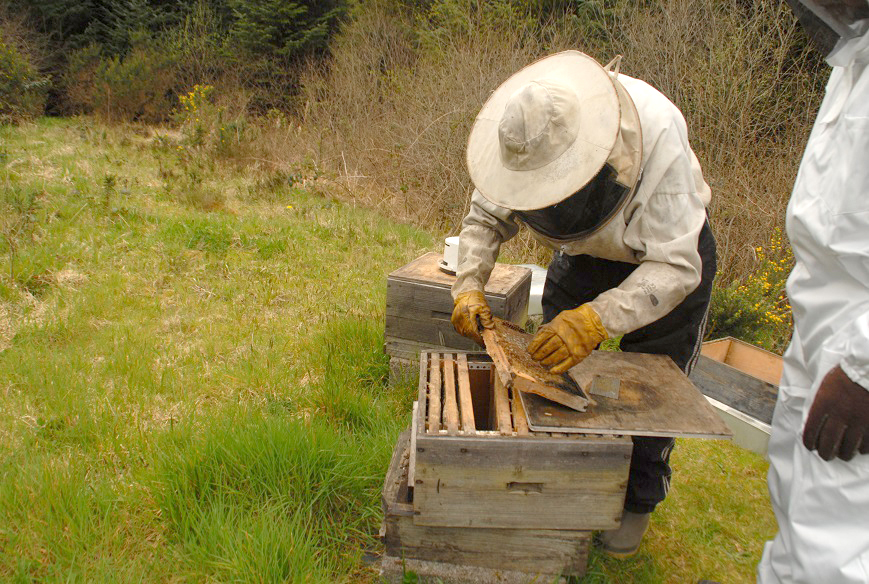
His finger (below) is pointing at the Queen Bee, which he keeps marked. When the hive is opened, the queen needs to be kept safe – if you can find her. An average hive has thousands of bees. The queen is trapped using the spiked ‘crown’ in the top of the image, and marked on the thorax with a felt tip pen.


We placed our first hive in the ‘orchard’, and bought a ‘nucleus’ from another beekeeper, which consists of a queen and 2,500 bees approximately.
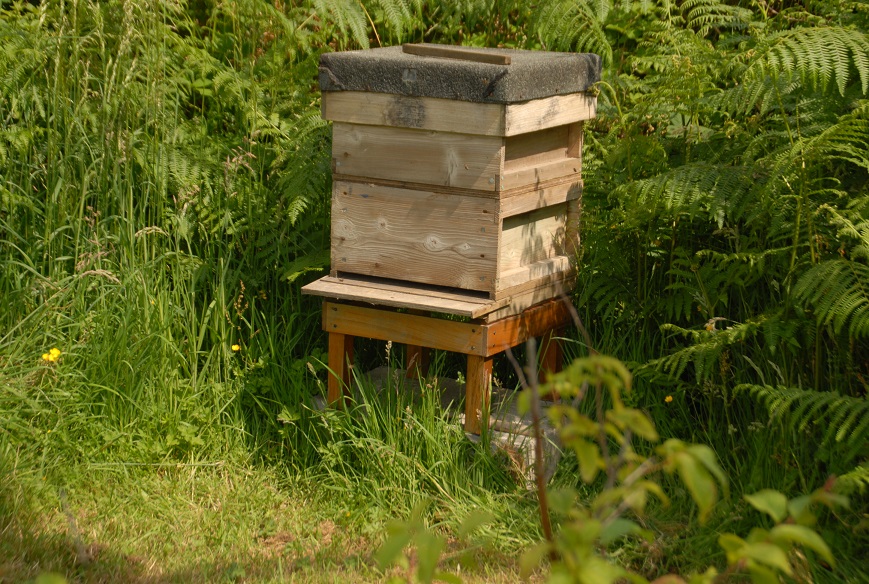
When the late summer came we found we had a wasp problem. Wasps will steal the honey and kill the bees. We put a wasp inhibitor on the front of the hive. It simply narrows the entrance and gives the bees a chance to kill the invaders (they cut off the wasp’s head as it goes in). However, by the late autumn the whole hive was decimated.

It wasn’t cheap buying a nucleus, so we set up a new hive in the top of our field, well away from the farm, and waited. A couple of years later we noticed a swarm had moved in, which was really exciting. This summer we placed a second empty hive in the top of the field and almost immediately another swarm moved in.
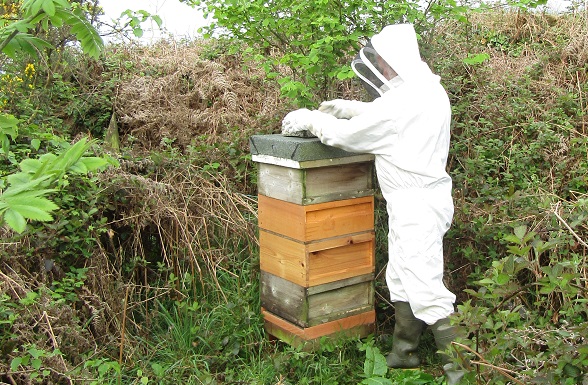
The lower box is the ‘brood box’ where the queen lays her eggs, and above that are the ‘supers’, boxes of frames which will be filled with honey for the winter, and from which we will harvest our own honey. The frames these days come as DIY packs, which we put together with a wax ‘base’ layer, the foundation, inside, on which the bees will build their cells.

The bees, of course, don’t always do what they’re told, and when the boxes are opened, there might be added constructions of cells, like the one hanging on the bottom of this frame.

Because bees like to glue things together, a ‘bee tool’ is needed to prize apart the frames for extraction. Note the hole in the hive cover (below, on the right). This is covered during the summer, but in the winter this will open into a box with a feeder filled with syrup, to keep the bees alive until summer, if they need it. Although we view spring as a lovely start to the year, for bees and birds it is the leanest time, when there is no fruit, little pollen, little nectar, and natural food supplies are scarce.
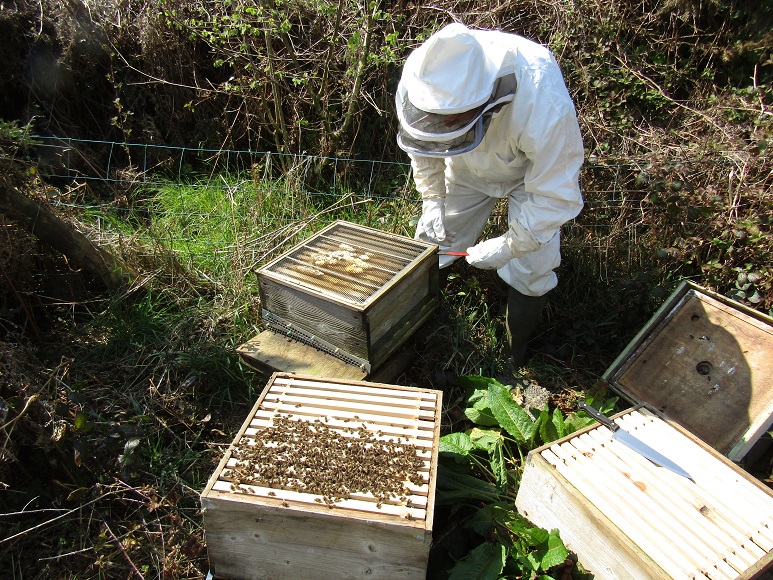
This is a feeder, designed to allow the bees to sip without falling in and drowning.

A ‘smoker’ is used to calm the bees when the hive is opened.
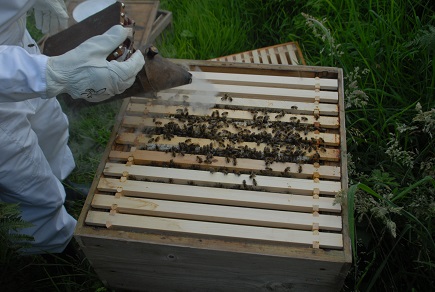
The small Irish bees seem to be a particularly calm breed, thankfully, and tend to mill about when the hive is opened, rather than go on the defensive – though we did both get stung this time, despite the bee suits. It is one of the drawbacks of stealing their honey!

A month ago we opened what had been an exceedingly busy hive, to check it for signs of predators, and for the possibility of taking some frames of honey. We had been active in destroying some well-established wasp nests on the farms around us, which had also flourished in the heat. One had been discovered accidentally by a neighbor while strimming verges. She was attacked ferociously, including her face and head. It left her severely traumatized. The stings took many weeks to settle. Luckily she didn’t get anaphylactic shock, which could have proved fatal.

The hive is checked by taking out few frames, and shunting the others along, rather than lifting them all out one by one.

This image below shows the ‘queen excluder’, a frame through which the smaller worker bees can go to store honey in the boxes above, but which keeps the larger queen bee in the brood chamber. This isn’t strictly necessary, but is a means of keeping the honey clean, with no insect bits or bee larvae to filter out.

Mice are another problem. They can often go into the hive and build a nest in the winter, so before such a mice invasion can occur, a mouse guard can be placed over the entrance. This is only required in the winter/spring when the mice are actively seeking somewhere warm and dry to bed down.

This last month (in August) we took four frames, heavy with honey, and replaced them with fresh blank frames.
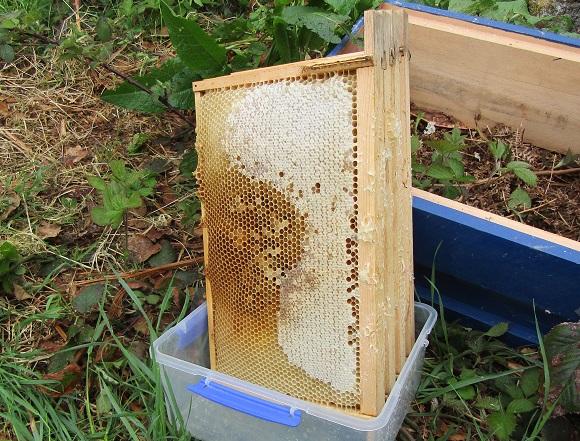
We took four pounds of honey from these frames. We don’t use a centrifuge for this small amount, so simply cut out the wax and drain the honey out through muslin for several days. The remnants are then melted down for the wax, with the intention of making candles. The frames can be reassembled with new foundation for later reuse.
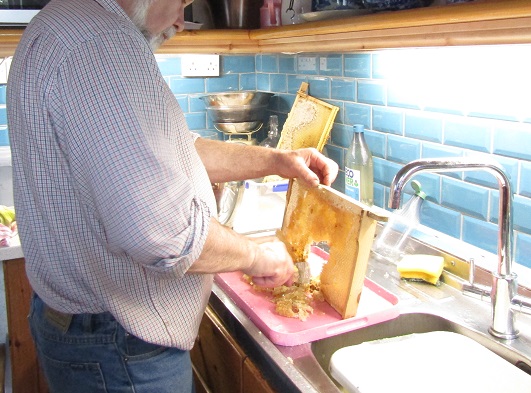
A tiny portion of our ‘home produce’ larder, with the new honey jars at the bottom, centre lower shelf.
